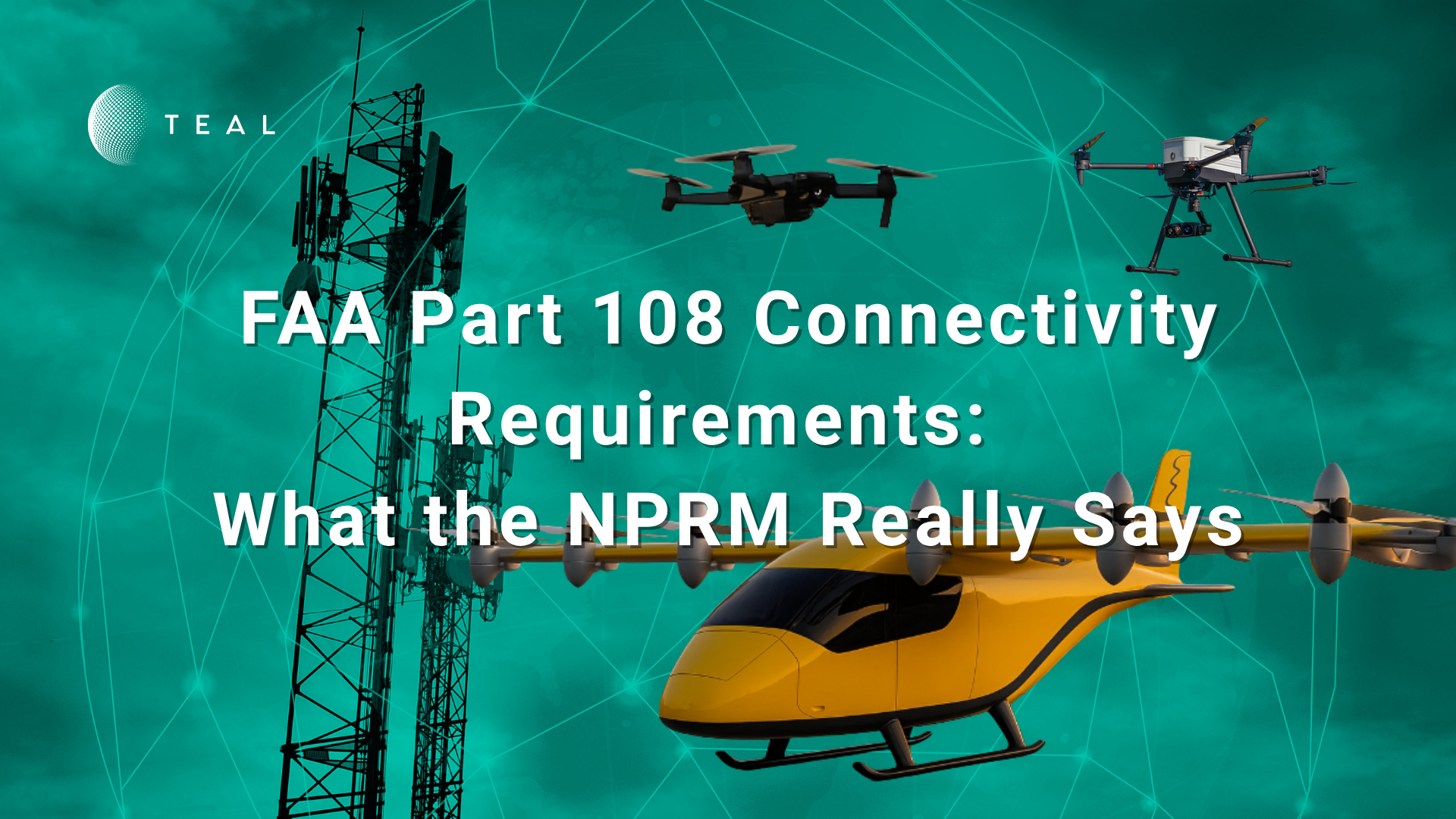FAA Part 108 Connectivity Requirements: What the NPRM Really Says

The Federal Aviation Administration has finally released its long-awaited Notice of Proposed Rulemaking (NPRM) for Part 108, establishing the regulatory framework for Beyond Visual Line of Sight (BVLOS) drone operations. This groundbreaking regulation promises to transform commercial drone operations by eliminating the need for individual waivers and creating standardized safety requirements. But buried within the 700+ page document are specific connectivity requirements fundamental to how drone operators approach communications infrastructure.
Understanding these connectivity requirements isn’t just important, it’s mission-critical for any organization planning to operate drones beyond visual line of sight. The FAA’s performance-based approach to connectivity establishes strict standards for reliability, security, and integration that will separate compliant operators from those left grounded.
This comprehensive analysis examines exactly what the NPRM states about connectivity requirements, why traditional approaches like MVNOs (Mobile Virtual Network Operators) fall short, and how operators can prepare for compliance with Part 108’s demanding communication standards.
Understanding FAA Part 108: The Foundation for BVLOS Operations
FAA Part 108 represents the most significant advancement in drone regulation since the introduction of Part 107. The proposed rule creates a structured pathway for routine BVLOS operations without requiring individual waivers, fundamentally changing how commercial drone operations scale across industries.
The regulation establishes performance-based safety requirements covering detect-and-avoid systems, communications, and navigation standards. Operations must remain at or below 400 feet above ground level and originate from pre-approved, access-controlled launch sites. The framework emphasizes risk-based categorization, with different requirements for shielded operations versus corridor flights.
Perhaps most importantly, Part 108 shifts accountability from individual pilots to operating companies. This change reflects the industrial nature of BVLOS operations, where systematic safety management becomes more critical than individual pilot judgment.
The regulation draws heavily from recommendations made by the FAA’s UAS Beyond Visual Line of Sight Aviation Rulemaking Committee (ARC), incorporating years of industry feedback and operational testing. Early data shows the potential impact: BVLOS waiver approvals jumped from approximately 1,200 in 2020 to nearly 27,000 in 2023, demonstrating massive industry demand for standardized operations.
Core Connectivity Requirements Under Part 108
The NPRM establishes three fundamental connectivity pillars that operators must implement for compliant BVLOS operations. These requirements go far beyond simple radio communication, demanding sophisticated digital infrastructure integration.
Remote ID via UAS Service Suppliers (USS)
All BVLOS flights under Part 108 must maintain continuous connectivity to an FAA-certified UAS Service Supplier. This requirement mandates internet-enabled data transmission throughout the entire mission, continuously broadcasting position, identification, and operational status updates.
The Remote ID system under Part 108 includes enhanced operational status messaging that specifically indicates BVLOS operation mode and takeoff location. The broadcast range must be optimized to enable situational awareness for other aircraft operating in the vicinity.
Automated Data Service Provider (ADSP) Integration
Operators must connect to FAA-approved Automated Data Service Providers for real-time operational coordination. ADSPs serve as the critical middleware between drone operators and the broader airspace management system, handling strategic deconfliction of flight plans, airspace coordination, and communication of operational updates.
The ADSP requirement becomes mandatory for operations in controlled airspace and flights over areas with population density of Category 3 or higher. This integration enables the distributed traffic management system that makes routine BVLOS operations possible.
Performance-Based Communications Standards
The NPRM establishes rigorous performance standards for command and control communications. These standards require secure uplink and downlink telemetry with sufficient data rates to support detect-and-avoid systems effectively.
Communication systems must demonstrate reliable coverage throughout the area of operations, with documented monitoring plans and lost-link procedures. The regulation emphasizes end-to-end reliability rather than specific technology mandates, allowing flexibility in implementation while maintaining safety outcomes.
Real-time health monitoring and failure alerting to operators or remote control stations becomes a mandatory capability. The system must execute predetermined safe actions when reaching link timeout thresholds, ensuring graceful degradation rather than catastrophic failure.
Data Security and Authentication Requirements
Part 108’s cybersecurity provisions reflect the critical nature of BVLOS operations in the national airspace system. The regulation requires operators to develop and implement comprehensive cybersecurity policies protecting networks, devices, and data from unauthorized access.
Specific cybersecurity requirements include processes for protecting software, hardware, and network computing infrastructure from unauthorized access. Employee network access privileges must be limited to those necessary for normal job duties, with immediate revocation for former employees.
Operators must prepare for, respond to, and mitigate cyber-attacks through documented procedures. The regulation requires continuous data collection and analysis to measure cybersecurity policy effectiveness, creating a feedback loop for continuous improvement.
The UAS equipment, systems, and networks must be protected from unauthorized electronic interactions. This requirement extends beyond basic encryption to encompass comprehensive electronic warfare protection and signal integrity verification.
Authentication methods must prevent unauthorized access to or interference with data exchanged between users and service providers. Validation and verification methods must provide assurance of data integrity and origin throughout the communication chain.
Why Cellular Carriers Matter (But Aren’t Specified)
The NPRM takes a technology-neutral approach to connectivity, focusing on performance outcomes rather than specific network technologies. The regulation does not explicitly name cellular carriers like Verizon, AT&T, or T-Mobile as pre-approved providers.
This performance-based framework allows operators to use any internet connectivity method that meets the stringent standards established in the regulation. Cellular networks can certainly qualify as acceptable connectivity channels, provided they deliver the required reliability, latency, and security characteristics.
Industry practice suggests using multiple carriers for redundancy and operational resilience. UPS Flight Forward and other early BVLOS operators commonly deploy multi-carrier networks combining primary and backup connections across different providers.
The key consideration isn’t which carrier to choose, but how to architect connectivity that meets Part 108’s performance requirements. Operators must demonstrate continuous, secure, low-latency communication capable of supporting real-time detect-and-avoid systems and mission coordination.
Coverage analysis becomes critical, as operators must maintain connectivity throughout their area of operations. The regulation requires communication assessments that include coverage mapping, availability analysis, and documented lost-link procedures for each operational area.
The MVNO Limitation: Why Resellers Won’t Meet Part 108 Standards
Mobile Virtual Network Operators represent an attractive option for many businesses due to their competitive pricing and flexible service offerings. However, MVNOs face fundamental limitations that make them unsuitable for FAA Part 108 compliance.
MVNOs lease network access from major carriers but lack direct control over core network parameters. They cannot access low-level Quality of Service controls or prioritize mission-critical UAV data during network congestion. This limitation becomes critical when BVLOS operations require guaranteed performance characteristics.
The absence of guaranteed Service Level Agreements for latency, jitter, throughput, and uptime creates compliance risks. Part 108’s performance-based requirements demand carrier-grade commitments that MVNOs cannot enforce through their wholesale relationships with network operators.
Security architecture presents another significant challenge. MVNOs don’t control core security infrastructure, making it difficult to implement end-to-end encryption policies or enforce SIM-based authentication aligned with FAA and NIST cybersecurity standards.
International roaming support through MVNOs relies on complex partner arrangements that can create unpredictable connectivity across borders. For operations requiring global coverage, these limitations become operational show-stoppers.
Perhaps most critically, MVNOs lack the regulatory traceability and UTM integration capabilities that Part 108 demands. The regulation requires deep integration with airspace management systems and traceable SIM device ownership that MVNOs cannot readily provide.
Preparing for Part 108 Connectivity Compliance
Organizations planning to operate under Part 108 should begin connectivity preparation immediately. The regulation’s 60-day comment period provides a narrow window to influence final rule language, making early engagement essential.
Technical Infrastructure Development
Evaluate both cellular and satellite communication links for robust command and control capabilities. Test LTE/5G networks alongside satellite providers like Starlink to create redundant communication pathways. Design systems with dynamic spectrum capability, allowing fallback between different communication methods based on signal quality and geographic coverage.
Implement detect-and-avoid systems integrated with your connectivity infrastructure for real-time alerting and evasive control. Ensure all devices and networks meet expected cybersecurity baseline protections while maintaining continuous Remote ID broadcast capability.
Operational Framework Establishment
Develop operations manuals reflecting new roles like Flight Operations Supervisor and Flight Coordinator with appropriate training documentation. Create chain of control procedures facilitating quick transfer of control during communication degradation, including automated return-to-home or safe-land triggers on link failure.
Document communication coverage throughout planned operational areas with detailed lost-link procedures for each location. Establish real-time health monitoring systems with immediate failure notification to operations centers.
Regulatory Engagement and Documentation
Submit substantive comments during the NPRM window, sharing real-world data from pilot programs using commercial wireless and satellite links. Document operational success cases from municipal or utility-driven BVLOS operations to support scalable adoption of flexible connectivity approaches.
Engage with spectrum policy development through FCC proceedings, particularly the consideration of 450 MHz band allocation for aeronautical command and control. Participate in industry standards development through ASTM and ANSI to influence connectivity certification pathways.
The Strategic Advantage of Carrier-Agnostic Solutions
The future of Part 108 compliance lies in flexible, carrier-agnostic connectivity platforms that can adapt to changing operational requirements and regulatory demands. Traditional single-carrier approaches lack the resilience and flexibility that BVLOS operations demand.
Dynamic eSIM network orchestration represents the most promising approach to Part 108 connectivity compliance. These platforms provide real-time network switching for seamless failover and coverage optimization while maintaining end-to-end SIM traceability and identity management aligned with FAA requirements.
Geofenced policy enforcement enables compliant operations across varied airspace and jurisdictions. Integration capabilities with UTM and ADSP ecosystems facilitate safe and coordinated BVLOS flights without requiring operators to manage complex integration projects internally.
Global scalability through pre-provisioned access to hundreds of networks across 150+ countries positions operators for international expansion as BVLOS regulations harmonize globally. This capability becomes increasingly valuable as supply chain and logistics applications drive cross-border drone operations.
Purpose-Built for BVLOS, Policy-Aligned, and Regulatory-Ready
TEAL provides a US-built, secure, carrier-agnostic, policy-aligned cellular connectivity platform designed for uncrewed aircraft systems (UAS) operating under FAA Part 108. With its dynamic eSIM orchestration capabilities, TEAL ensures safety-critical communications are reliable, secure, and FAA-compliant.
Why TEAL Will Be the Preferred Cellular Connectivity Option for FAA Part 108
TEAL’s platform purpose-built for critical UAS operations, making it uniquely positioned to meet the demands of FAA Part 108. Unlike MVNOs or single-network providers, TEAL offers dynamic network orchestration across multiple Tier-1 carriers, ensuring resilient, redundant, and low-latency links required for BVLOS operations to ensure that communications are FAA-compliant.
TEAL’s platform supports:
- Native tier-1 carrier profiles for low-latency, high-throughput performance that is not hindered by roaming limitations.
- Real-time network switching for seamless failover and coverage optimization.
- End-to-end SIM traceability and identity management, aligning with FAA cybersecurity and Remote ID mandates.
- Network-level QoS and SLAs that meet BVLOS latency and reliability needs
- Geofenced policy enforcement, enabling compliant operations across varied airspace and jurisdictions.
- Integration with UTM and ADSP ecosystems, facilitating safe and coordinated BVLOS flights.
- Global scalability with pre-provisioned access to hundreds of networks across 196+ countries.
In the context of Part 108’s performance-based standards for safety, connectivity assurance, and regulatory traceability, TEAL represents not just a connectivity provider, but a mission-critical compliance enabler.
| Feature / Capability | MVNO (Mobile Virtual Network Operator) | MNO (Mobile Network Operator) | TEAL’s Network Orchestrator Service (NOS) |
| Network Control | ❌ None — Resells network access only | ✅ Full control over RAN/core | ✅ Dynamic control via API orchestration |
| Quality of Service (QoS) | ❌ No low-level QoS config | ✅ SLA-backed QoS support | ✅ Multi-carrier QoS selection + redundancy |
| SLAs (Latency, Jitter, Uptime) | ❌ Not offered or enforceable | ✅ Yes, tiered by use case | ✅ SLAs via orchestration + fallback options |
| C2 Link Reliability | ⚠️ Variable, uncontrolled | ✅ Prioritized and monitored | ✅ Carrier-agnostic with intelligent fallback |
| DAA & Remote ID Support via Network APIs | ❌ Rare or unavailable | ✅ Yes (with edge/5G API support) | ✅ Supported via integrated UTM hooks |
| Multi-carrier Redundancy | ❌ No | ⚠️ Requires separate SIMs/contracts | ✅ Single SIM, dynamic carrier switching |
| Policy-Aligned Spectrum Use (e.g. 5G Slicing) | ❌ Not supported | ✅ Yes (via slicing, NPNs) | ✅ Supported with programmable policy |
| Security & Cyber Compliance (NIST, FAA) | ❌ Weak—no core access or guarantees | ✅ Controlled environment | ✅ SIM-based identity + secure provisioning |
| SIM Identity & Traceability | ⚠️ Limited | ✅ Carrier-registered | ✅ Fully traceable via orchestration platform |
| Roaming Control (Geo-fenced UAV Operations) | ❌ Basic roaming, inconsistent | ⚠️ Requires coordination | ✅ Geofenced, policy-driven roaming profiles |
| Network Handover Support (Fast, Seamless) | ⚠️ Variable latency | ✅ Optimized by MNO | ✅ Optimized + multi-network awareness |
| Airspace Integration (UTM / ADSP) | ❌ Not integrated | ⚠️ Custom partnerships needed | ✅ Direct support for UTM ecosystem hooks |
| Pricing | ✅ Low-cost | ⚠️ Moderate–High | ⚠️ Variable |
| FAA Part 108 Alignment | ❌ Inadequate for safety-critical ops | ✅ Strong (if tailored) | ✅ Best-fit (policy-compliant & resilient) |
Charting the Path Forward for BVLOS Connectivity
FAA Part 108 represents more than regulatory compliance; it establishes the foundation for routine commercial drone operations at unprecedented scale. The connectivity requirements embedded within this regulation will determine which organizations successfully transition from experimental operations to industrial-scale deployment.
The performance-based approach to connectivity creates opportunities for innovation while maintaining strict safety standards. Organizations that invest in flexible, resilient connectivity solutions will be better positioned to adapt to evolving regulations and operational demands. By prioritizing reliable communication systems, these organizations can ensure safe and efficient drone operations, paving the way for broader industry growth and technological advancement.
Find out how you can ensure policy-aligned connectivity for your BVLOS drone operations.
Schedule a free consultation with a TEAL expert today!
Book a Meeting Now!
Recent Posts
Introducing TEAL Chameleon eSIM: The Most Adaptive eSIM Ever Built
Teal Communications Staff2025-12-03T23:14:56+00:00
TEAL Ranked as the Fastest-Growing Company in the Pacific Northwest on the 2025 Deloitte Technology Fast 500™
Teal Communications Staff2025-11-19T04:37:11+00:00
SenseNet Partners With TEAL to Expand AI-Powered Wildfire and Gas Leak Detection Globally
Teal Communications Staff2025-11-12T17:24:11+00:00




